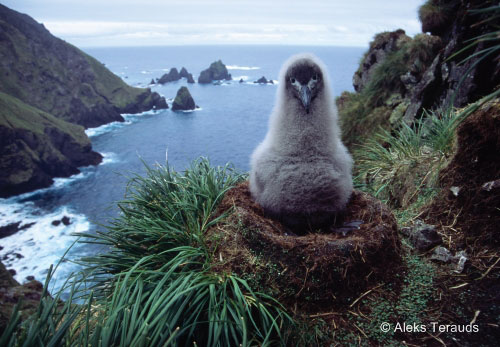Elsa Bonnaud (University of La Laguna, Canary Islands, Spain) and colleagues writing in the journal Biological Invasions have reviewed the diets of feral cats Felis catus introduced to islands, finding that 113 species of birds have been recorded as prey.
ACAP-listed species recorded include Grey Procellaria cinerea and White-chinned P. aequinoctialis Petrels and two species of mollymawk albatrosses Thalassarche spp., as well as a number of Puffinus shearwaters.
The paper's abstract follows:
"Cats are among the most successful and damaging invaders on islands and a significant driver of extinction and endangerment. Better understanding of their ecology can improve effective management actions such as eradication. We reviewed 72 studies of insular feral cat diet from 40 islands worldwide. Cats fed on a wide range of species from large birds and medium sized mammals to small insects with at least 248 species consumed (27 mammals, 113 birds, 34 reptiles, 3 amphibians, 2 fish and 69 invertebrates). Three mammals, 29 birds and 3 reptiles recorded in the diet of cats are listed as threatened by the IUCN. However, a few species of introduced mammals were the most frequent prey, and on almost all islands mammals and birds contributed most of the daily food intake. Latitude was positively correlated with the predation of rabbits and negatively with the predation of reptiles and invertebrates. Distance from landmass was positively correlated with predation on birds and negatively correlated with the predation of reptiles. The broad range of taxa consumed by feral cats on islands suggests that they have the potential to impact almost any native species, even the smallest ones under several grams, that lack behavioral, morphological or life history adaptations to mammalian predators. Insular feral cat's reliance on introduced mammals, which evolved with cat predation, suggests that on many islands, populations of native species have already been reduced."
Reference:
Bonnaud, E., Medina, F.M., Vidal, E., Nogales, M., Tershy, B., Zavaleta, E., Donlan, C.J., Keitt, B., Le Corre, M. & Horwath, S.V. 2011. The diet of feral cats on islands: a review and a call for more studies. Biological Invasions 13: 581-603.
The following paper was not included within the review. It reports a feral cat at sub-Antarctic Marion Island feeding on a freshly-killed Light-mantled Sooty Albatross Phoebetria palpebrata chick.
Berruti, A. 1981. The status of the Royal Penguin and Fairy Prion at Marion Island, with notes on feral cat predation on nestlings of large birds. Cormorant 9: 123-128.

John Cooper, ACAP Information Officer, 7 July 2011

 English
English  Français
Français  Español
Español